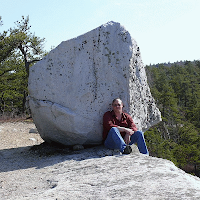While driving through northeastern New Jersey recently, my wife and I made a detour to see a rock outcrop I had read about but never seen. It's located in the middle of a private housing development in Hamburg, a small town in northwestern New Jersey. It's a beautiful rock outcrop but also geologically significant.
This particular dolostone was deposited between the Middle Cambrian to the start of the Ordovician Periods of geologic time - roughly 500 million years ago. At that time, North America was rotated 90° clockwise and what's now the east coast of the United States was the south coast and in subtropical southern latitudes. The area was under seawater and part of the continental shelf. You can see similar dolostones of the same age here in the Hudson Valley. They're called the Wappinger Group and are well exposed in eastern Dutchess County - here are some SUNY Ulster students examining the rock on Lime Kiln Road off I-84 near Fishkill.
When these rocks were being deposited as seafloor sediments, there was no life at all on land. The seas were teeming with marine invertebrates and even a few early chordates (eel-like animals) but no true vertebrates (fish) yet. But, for almost 3 billion years (yes, billion!), a very special group of organisms existed on the world's seafloors and without whom there would possibly be no animal life on Earth.
The fossils in the Hamburg, NJ outcrop are called stromatolites. They actually formed from single-celled bacteria called cyanobacteria (cyan referring to a blue-green color). Cyanobacteria were among the first organisms on Earth to develop the process of photosynthesis - something today we associate with green plants. Photosynthesis basically takes water and carbon dioxide, with the energy of sunlight, and creates glucose (a simple sugar) and oxygen as a waste product.
The early Earth's atmosphere had no oxygen. It did, however, have plenty of carbon dioxide. Mats of these cyanobacteria sat on the shallow seafloor and happily photosynthesized carbon dioxide into oxygen. For billions of years. Once oxygen levels built up enough, simple bacterial cells evolved (through a process called endosymbiosis) into more complex cells with a nucleus and organelles. This led, in short order (geologically-speaking) to multicellular life (metazoans) which used the oxygen now existing in the atmosphere.
Even though the individual cyanobacteria cells were microscopic, together they formed sticky mats on the seafloor which trapped sediments over time. The bacterial cells grew up on top of the sediments and trapped some more. Over and over again eventually forming finely laminated mounds of sediment. While the cyanobacteria themselves were not preserved, the layered mounds were and are called stromatolites. Stromatolite fossils are found in other places - here in New York you can also view them (about the same age as those in New Jersey) just east of Saratoga Springs at a place called Lester Park.
Stromatolites still exist today, although they are quite rare and found only in a few environments (most notably, Shark Bay in Western Australia). Half a billion years ago, in shallow subtropical waters of a continental shelf in what's now New Jersey, these stromatolites lived their lives.
Thank them - the oxygen they produced made it possible for our earliest ancestors to evolve.





